The Portable Gas Detection Equipment Market is estimated to be valued at USD 1.9 billion in 2025 and is projected to reach USD 2.9 billion by 2035, registering a compound annual growth rate (CAGR) of 4.3% over the forecast period.
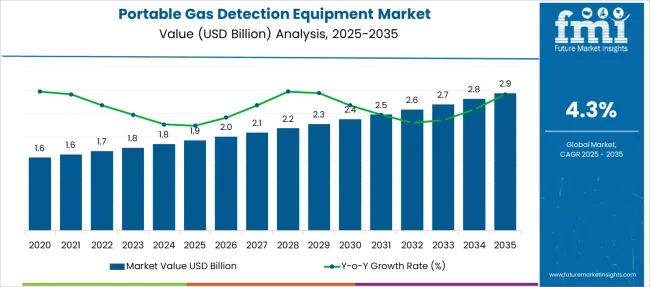
| Metric | Value |
|---|---|
| Portable Gas Detection Equipment Market Estimated Value in (2025 E) | USD 1.9 billion |
| Portable Gas Detection Equipment Market Forecast Value in (2035 F) | USD 2.9 billion |
| Forecast CAGR (2025 to 2035) | 4.3% |
The portable gas detection equipment market is expanding steadily as safety regulations and industrial safety standards become more stringent worldwide. Increased awareness about hazardous gas exposure risks has led industries to adopt advanced detection technologies to protect workers and ensure regulatory compliance.
Developments in sensor technology have improved the accuracy sensitivity and reliability of portable devices, enabling faster detection of toxic and combustible gases in real time. Growing industrialization and the rise of high-risk workplaces such as oil and gas plants manufacturing facilities and chemical processing units have driven demand for portable and wearable gas detectors.
Additionally the focus on worker safety and occupational health has accelerated the use of portable devices that offer mobility and ease of use in challenging environments. The market is expected to grow further due to continuous innovations in wearable technology and integration with wireless communication systems. Segment growth is anticipated to be led by wearable gas detectors in product type and the industrial sector as the key end-use segment.
The market is segmented by Product Type and End-Use and region. By Product Type, the market is divided into Wearable Gas Detectors, Non-wearable Gas Detectors, Sniffer, and Others. In terms of End-Use, the market is classified into Industrial, Oil & Portable Gas, Mining, Building Automation, and Others. Regionally, the market is classified into North America, Latin America, Western Europe, Eastern Europe, Balkan & Baltic Countries, Russia & Belarus, Central Asia, East Asia, South Asia & Pacific, and the Middle East & Africa.
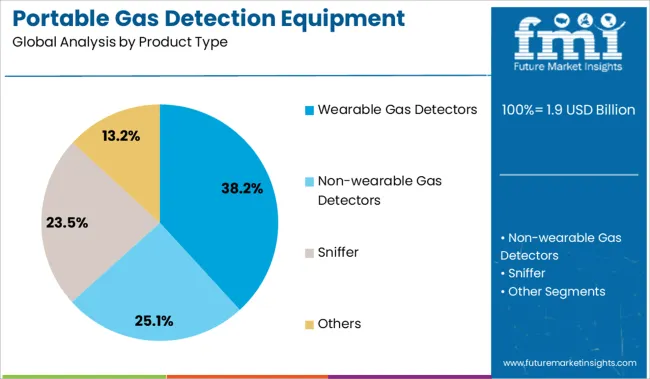
The wearable gas detectors segment is projected to represent 38.2% of the portable gas detection equipment market revenue in 2025 maintaining its position as the leading product type. Growth in this segment has been driven by the increasing demand for compact lightweight and user-friendly devices that can be worn by workers for continuous gas monitoring. Wearable detectors provide real-time alerts enabling immediate response to hazardous gas presence improving workplace safety.
The portability and convenience of these devices make them suitable for various industrial settings where mobility and hands-free operation are critical. Enhanced battery life and multi-gas detection capabilities have further increased their adoption.
As industries emphasize proactive safety measures wearable gas detectors are expected to sustain their market dominance.
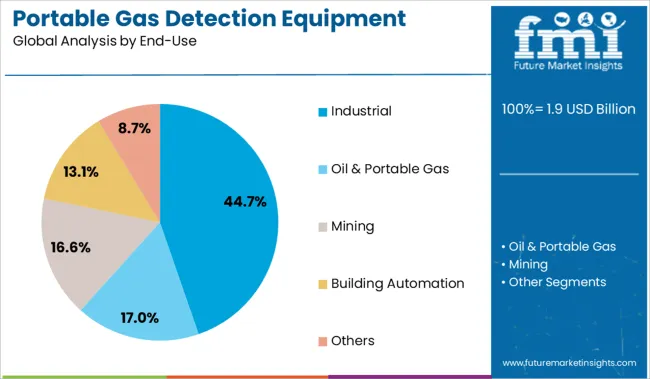
The industrial segment is forecasted to hold 44.7% of the market revenue in 2025 retaining its position as the leading end-use category. Growth in this segment has been fueled by the widespread use of portable gas detection equipment in manufacturing plants oil refineries chemical processing units and other high-risk industrial environments. Industrial safety protocols mandate continuous gas monitoring to prevent accidents and ensure worker safety.
The segment benefits from stringent regulations and growing investments in occupational health and safety programs. Increasing industrialization especially in emerging economies has expanded the market base.
As industries continue to prioritize compliance and workplace safety the industrial segment is expected to maintain its dominant share.
As per the Portable Gas Detection Equipment Market research by Future Market Insights - a market research and competitive intelligence provider, historically, from 2020 to 2024, the market value of the Portable Gas Detection Equipment Market increased at around 4.8% CAGR.
Governments throughout the world are working to limit methane emissions from oil and gas, which is increasing the demand for portable gas detection equipment. Since they are crucial for regulating efficiency and safety in a range of applications, infrared gas detection sensors are frequently employed for methane gas detection. The use of gas detecting systems during transportation, natural gas extraction, and power generation can help to reduce methane leakage. A new joint agreement between the European Union and the United States to reduce worldwide methane emissions by 30% by 2035 can be a critical step in combating climate change and bringing the world closer to the Paris Agreement's objective of keeping global temperature rise below 2°C.
New HART (Highway Addressable Remote Transducer) Communications Protocols now make gas sensors available, bringing up new commercial opportunities. HART is a communications technology for instruments that provides consistent and reliable transmission while avoiding interference with 4-20 mA analog signals. It provides several benefits to corporate teams by sending significant information to huge corporate networks and specialized units. Gas detectors that accept the HART 7 protocol can use HART to communicate sensor status to a plant's maintenance system.
Bluetooth-enabled gas detection equipment is becoming more prevalent. Using this wireless technology, users may share real-time air quality measures with their colleagues. Several firms are collaborating to create Bluetooth-enabled gas detection devices. As a proof-of-concept for ambient air monitoring applications, malodor olfactometric control, and landfill gas monitoring, some of the firms are manufacturing portable sensor systems based on solid-state gas sensors.
Commercial gas sensors and nanotechnology sensors are also stacked in an array style for multi-sensing and multi-parameter devices. Wireless sensors are incorporated at a cheap cost to create a portable and mobile node that may be utilized as an early detection system in a dispersed sensor network.
The presence of severe safety standards in a range of sectors is one of the primary reasons driving the growth of the portable gas detectors market. Increased portable gas detectors demand in the mining industry to prevent disasters caused by poisonous gases, vapors, and other hazardous chemicals in deep mines, as well as the widespread use of the devices to maintain safe working conditions, drive market expansion. The market is being influenced by increased demand for portable gas detectors integrated with Internet of Things (IoT) and artificial intelligence (AI) technologies for assisting predictive maintenance, as well as the need for real-time data analysis and sending warnings to miners located at various locations within mines during gas leakages.
As a consequence of product innovation and technical advancements, modern wireless gas detectors that can identify dangerous gases and monitor gas concentrations in difficult-to-reach areas have been developed. Wireless gas detectors can detect a variety of dangerous industrial gases, including carbon dioxide and ammonia.
Because of rising petroleum prices and environmental concerns, natural gas is becoming increasingly popular as a transportation fuel. As a result, as the number of natural gas filling stations grows, so does the demand for natural gas detectors to prevent disasters.
Asia Pacific is the most lucrative region with the highest projected growth. This region's rise is mostly due to tight government laws governing occupational safety. With the region's fast development, greenhouse gas emissions have skyrocketed, necessitating the installation of gas detection systems.
According to China National Petroleum, China's gas consumption exceeded around 1.8 billion cubic meters in 2024, while the rate of rise in gas imports is expected to slow significantly. As a result, China intends to lessen its reliance on gas imports by boosting indigenous developments such as shale formations. Gas detectors are required for these projects to guarantee safety.
Also in India, as new industries grow natural gas consumption in the country is estimated to reach 2.9 million standard cubic meters per day (mmscmd) by 2035, slightly higher compared to around 174 mmscmd, which proportionates the requirement for gas detection equipment.
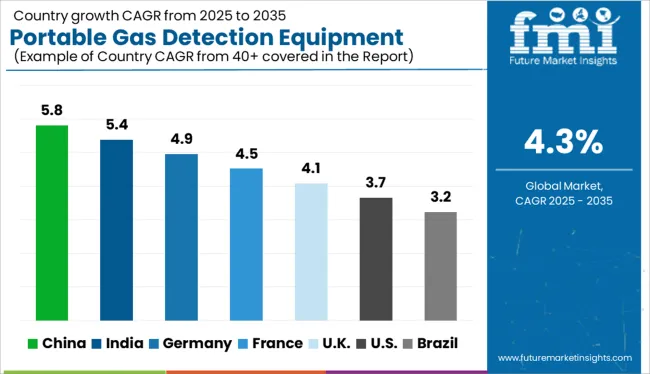
The United States is expected to have the highest market share of USD 2.9 Million by the end of 2035. Increased shale gas production, as well as technical advances in extraction, are expected to drive market growth in the United States. Natural gas is becoming more popular as a transportation fuel due to growing petroleum prices and environmental concerns. As a result, the increasing number of natural gas filling stations is increasing the demand for natural gas detectors to prevent mishaps.
The rising need for the safety and protection of employees who are regularly exposed to harmful gases is propelling market expansion. The Portable Gas Detection Equipment Market is growing due to an increase in demand for accident prevention due to gas leaks. Carbon monoxide poisoning kills thousands of American workers each year, making it one of the most dangerous and common occupational hazards. Aside from alcohol, carbon monoxide is the largest cause of death. Another 10,000 workers are suffering from the incapacitating effects of high-level exposure.
Several projects related to the country’s development are being undertaken by the US government and companies for early detection and emission control. For instance, Honeywell established the Emissions Control and Reduction Initiative to assist clients in achieving carbon neutrality across a variety of sectors. The project will initially help oil and gas companies with upstream, middle, and downstream operations detect and reduce fugitive methane emissions, which trap 25 times more heat in the atmosphere than carbon dioxide.
By combining its fixed, portable, and personal gas detection systems with gas cloud imaging cameras, Honeywell will provide its clients with early detection of fugitive methane emissions, as well as the precise location of any leaks and associated data analytics and trends. With this information, users may move immediately to remedy leaks and other detected hazards, reducing production losses and ensuring compliance with regulations.
The industrial segment is forecasted to grow at the highest CAGR of over 4.2% from 2025 to 2035. Portable gas detectors are used to safeguard people and employees in a variety of industries throughout the world, and each device is designed to ensure that it is suitable for its purpose. Workers can work for extended periods of time in potentially dangerous conditions where the presence of toxic gases would typically make work impossible by specifying and using the proper portable gas detector.
Leakage monitoring requires mounting the measuring head with consideration for potential leakage points such as flanges, valves, pressure reducers, pumps, and so on. This enables the early detection of leakage. Detectors are equally dispersed over the hazardous region depending on local flow conditions in places where there are no well-defined suspected leakage sources, such as chemical and paint warehouses.
It is critical to select the finest gas detector. A gas portable gas monitoring equipment sensor must be fast and precise, with no interference from other gases in the vicinity. In an industrial automation facility containing lead, sulfur, or other impurities, a catalytic-type gas sensor should not be utilized. These gas vapors may degrade catalytic beads and impair detection sensitivity. Although there are no official standards governing a gas detector's specific area of coverage, common requirements for fixed-point gas detectors in open spaces include a 5m radius coverage for each detector or 75 to 100 square meters per detector.
The Non-Wearable segment is forecasted to grow at the highest CAGR of over 3.7% from 2025 to 2035. Because of its low cost and enhanced technical advantages such as low power consumption, as well as Bluetooth, cellular technology, and Wi-Fi sensors built into the device, the non-wearable portable gas detector is ideal for all applications.
Among non-wearables, sniffers are majorly used for gas detection. Atmospheric sniff systems are majorly used in HVAC (heating, ventilation, and air conditioning), aerospace, and other industries for the quick and effective location of leaks during assembly.
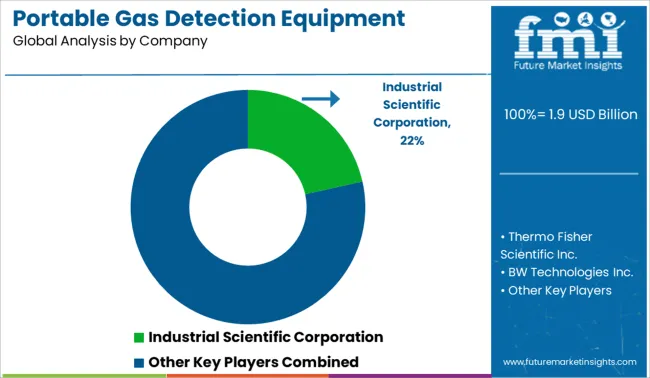
Among the leading players in the global Portable Gas Detection Equipment Market include Industrial Scientific Corporation, Drägerwerk AG & Co. KGaA, Mine Safety Appliances, Crowcon Detection Instruments, Ltd., and Trolex Ltd. To gain a competitive advantage in the industry, these players are investing in product launches, partnerships, mergers and acquisitions, and expansions.
The market growth is expected to be fuelled by collaborations among current gas monitors & detection equipment companies to improve quality throughout the research period. Over the projection period, the established market players are expected to diversify their portfolios and offer one-stop solutions to combat fierce competition.
In December 2024, Drager launched its new MetCam optical gas detection camera which detects and monitors methane leakage in real time, even in tough environments. As a result, possible hazards posed by escaping gases may be assessed more quickly and precisely. Metacam augments traditional point gas detection systems with area monitoring.
In July 2024, MSA Safety Incorporated completed its USD 337 Million acquisition of Bacharach, Inc. The latter is a global pioneer in gas detection technology used in the heating, ventilation, air conditioning, and refrigeration industries.
Similarly, recent developments related to companies in Portable Gas Detection Equipment services have been tracked by the team at Future Market Insights, which are available in the full report.
The global portable gas detection equipment market is estimated to be valued at USD 1.9 billion in 2025.
The market size for the portable gas detection equipment market is projected to reach USD 2.9 billion by 2035.
The portable gas detection equipment market is expected to grow at a 4.3% CAGR between 2025 and 2035.
The key product types in portable gas detection equipment market are wearable gas detectors, non-wearable gas detectors, sniffer and others.
In terms of end-use, industrial segment to command 44.7% share in the portable gas detection equipment market in 2025.






Our Research Products

The "Full Research Suite" delivers actionable market intel, deep dives on markets or technologies, so clients act faster, cut risk, and unlock growth.

The Leaderboard benchmarks and ranks top vendors, classifying them as Established Leaders, Leading Challengers, or Disruptors & Challengers.

Locates where complements amplify value and substitutes erode it, forecasting net impact by horizon

We deliver granular, decision-grade intel: market sizing, 5-year forecasts, pricing, adoption, usage, revenue, and operational KPIs—plus competitor tracking, regulation, and value chains—across 60 countries broadly.

Spot the shifts before they hit your P&L. We track inflection points, adoption curves, pricing moves, and ecosystem plays to show where demand is heading, why it is changing, and what to do next across high-growth markets and disruptive tech

Real-time reads of user behavior. We track shifting priorities, perceptions of today’s and next-gen services, and provider experience, then pace how fast tech moves from trial to adoption, blending buyer, consumer, and channel inputs with social signals (#WhySwitch, #UX).

Partner with our analyst team to build a custom report designed around your business priorities. From analysing market trends to assessing competitors or crafting bespoke datasets, we tailor insights to your needs.
Supplier Intelligence
Discovery & Profiling
Capacity & Footprint
Performance & Risk
Compliance & Governance
Commercial Readiness
Who Supplies Whom
Scorecards & Shortlists
Playbooks & Docs
Category Intelligence
Definition & Scope
Demand & Use Cases
Cost Drivers
Market Structure
Supply Chain Map
Trade & Policy
Operating Norms
Deliverables
Buyer Intelligence
Account Basics
Spend & Scope
Procurement Model
Vendor Requirements
Terms & Policies
Entry Strategy
Pain Points & Triggers
Outputs
Pricing Analysis
Benchmarks
Trends
Should-Cost
Indexation
Landed Cost
Commercial Terms
Deliverables
Brand Analysis
Positioning & Value Prop
Share & Presence
Customer Evidence
Go-to-Market
Digital & Reputation
Compliance & Trust
KPIs & Gaps
Outputs
Full Research Suite comprises of:
Market outlook & trends analysis
Interviews & case studies
Strategic recommendations
Vendor profiles & capabilities analysis
5-year forecasts
8 regions and 60+ country-level data splits
Market segment data splits
12 months of continuous data updates
DELIVERED AS:
PDF EXCEL ONLINE
Portable Audiometer Calibration System Market Size and Share Forecast Outlook 2025 to 2035
Portable Crushers Market Size and Share Forecast Outlook 2025 to 2035
Portable Filtration System Market Size and Share Forecast Outlook 2025 to 2035
Portable Toilet Rental Market Size and Share Forecast Outlook 2025 to 2035
Portable NIR Moisture Meter Market Forecast and Outlook 2025 to 2035
Portable Appliance Tester (PAT) Market Size and Share Forecast Outlook 2025 to 2035
Portable Boring Machines Market Size and Share Forecast Outlook 2025 to 2035
Portable Charging Units Market Size and Share Forecast Outlook 2025 to 2035
Portable Electronic Analgesic Pump Market Size and Share Forecast Outlook 2025 to 2035
Portable Ramps Market Size and Share Forecast Outlook 2025 to 2035
Portable Buffet and Drop-In Ranges Market Size and Share Forecast Outlook 2025 to 2035
Portable Cancer Screen Devices Market Size and Share Forecast Outlook 2025 to 2035
Portable Hydrogen Powered Generator Market Size and Share Forecast Outlook 2025 to 2035
Portable Milling Machine Market Size and Share Forecast Outlook 2025 to 2035
Portable Power Quality Meter Market Size and Share Forecast Outlook 2025 to 2035
Portable Sandwich Maker Market Size and Share Forecast Outlook 2025 to 2035
Portable Conventional Generator Market Size and Share Forecast Outlook 2025 to 2035
Portable Projector Market Size and Share Forecast Outlook 2025 to 2035
Portable Printer Market Size and Share Forecast Outlook 2025 to 2035
Portable Video Wall Market Size and Share Forecast Outlook 2025 to 2035

Thank you!
You will receive an email from our Business Development Manager. Please be sure to check your SPAM/JUNK folder too.
Chat With
MaRIA